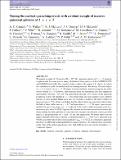Files in this item
Timing the earliest quenching events with a robust sample of massive quiescent galaxies at 2 < z < 5
Item metadata
| dc.contributor.author | Carnall, A. C. | |
| dc.contributor.author | Walker, S. | |
| dc.contributor.author | McLure, R. J. | |
| dc.contributor.author | Dunlop, J. S. | |
| dc.contributor.author | McLeod, D. J. | |
| dc.contributor.author | Cullen, F. | |
| dc.contributor.author | Wild, V. | |
| dc.contributor.author | Amorin, R. | |
| dc.contributor.author | Bolzonella, M. | |
| dc.contributor.author | Castellano, M. | |
| dc.contributor.author | Cimatti, A. | |
| dc.contributor.author | Cucciati, O. | |
| dc.contributor.author | Fontana, A. | |
| dc.contributor.author | Gargiulo, A. | |
| dc.contributor.author | Garilli, B. | |
| dc.contributor.author | Jarvis, M. J. | |
| dc.contributor.author | Pentericci, L. | |
| dc.contributor.author | Pozzetti, L. | |
| dc.contributor.author | Zamorani, G. | |
| dc.contributor.author | Calabro, A. | |
| dc.contributor.author | Hathi, N. P. | |
| dc.contributor.author | Koekemoer, A. M. | |
| dc.date.accessioned | 2020-11-02T16:30:05Z | |
| dc.date.available | 2020-11-02T16:30:05Z | |
| dc.date.issued | 2020-07 | |
| dc.identifier.citation | Carnall , A C , Walker , S , McLure , R J , Dunlop , J S , McLeod , D J , Cullen , F , Wild , V , Amorin , R , Bolzonella , M , Castellano , M , Cimatti , A , Cucciati , O , Fontana , A , Gargiulo , A , Garilli , B , Jarvis , M J , Pentericci , L , Pozzetti , L , Zamorani , G , Calabro , A , Hathi , N P & Koekemoer , A M 2020 , ' Timing the earliest quenching events with a robust sample of massive quiescent galaxies at 2 < z < 5 ' , Monthly Notices of the Royal Astronomical Society , vol. 496 , no. 1 , pp. 695–707 . https://doi.org/10.1093/mnras/staa1535 | en |
| dc.identifier.issn | 0035-8711 | |
| dc.identifier.other | PURE: 266312399 | |
| dc.identifier.other | PURE UUID: eaead1ae-cc86-4d1a-bb83-b7746b961b03 | |
| dc.identifier.other | BibCode: 2020arXiv200111975C | |
| dc.identifier.other | WOS: 000560784700053 | |
| dc.identifier.other | Scopus: 85088304752 | |
| dc.identifier.uri | https://hdl.handle.net/10023/20885 | |
| dc.description | Funding: ACC and FC acknowledge the support of the UK Science and Technology Facilities Council. AC acknowledges the grant nos ASI n.2018-23-HH.0,PRIN MIUR 2015, and PRIN MIUR 2017 – 20173ML3WW_001. | en |
| dc.description.abstract | We present a sample of 151 massive (M* > 1010 M⊙) quiescent galaxies at 2 < z < 5, based on a sophisticated Bayesian spectral energy distribution fitting analysis of the CANDELS UDS and GOODS-South fields. Our sample includes a robust sub-sample of 61 objects for which we confidently exclude low-redshift and star-forming solutions. We identify 10 robust objects at z > 3, of which 2 are at z > 4. We report formation redshifts, demonstrating that the oldest objects formed at z > 6; however, individual ages from our photometric data have significant uncertainties, typically ∼0.5 Gyr. We demonstrate that the UVJ colours of the quiescent population evolve with redshift at z > 3, becoming bluer and more similar to post-starburst galaxies at lower redshift. Based upon this, we construct a model for the time evolution of quiescent galaxy UVJ colours, concluding that the oldest objects are consistent with forming the bulk of their stellar mass at z ∼ 6–7 and quenching at z ∼ 5. We report spectroscopic redshifts for two of our objects at z = 3.440 and 3.396, which exhibit extremely weak Ly α emission in ultra-deep VANDELS spectra. We calculate star formation rates based on these line fluxes, finding that these galaxies are consistent with our quiescent selection criteria, provided their Ly α escape fractions are >3 and >10 per cent, respectively. We finally report that our highest redshift robust object exhibits a continuum break at λ ∼ 7000 Å in a spectrum from VUDS, consistent with our photometric redshift of zphot=4.72+0.06−0.04. If confirmed as quiescent, this object would be the highest redshift known quiescent galaxy. To obtain stronger constraints on the times of the earliest quenching events, high-SNR spectroscopy must be extended to z ≳ 3 quiescent objects. | |
| dc.format.extent | 13 | |
| dc.language.iso | eng | |
| dc.relation.ispartof | Monthly Notices of the Royal Astronomical Society | en |
| dc.rights | Copyright © 2020 The Author(s). Published by Oxford University Press on behalf of the Royal Astronomical Society. This work has been made available online in accordance with publisher policies or with permission. Permission for further reuse of this content should be sought from the publisher or the rights holder. This is the final published version of the work, which was originally published at https://doi.org/10.1093/mnras/staa1535. | en |
| dc.subject | Methods: statistical | en |
| dc.subject | Galaxies: evolution | en |
| dc.subject | Galaxies: star formation | en |
| dc.subject | QB Astronomy | en |
| dc.subject | QC Physics | en |
| dc.subject | 3rd-DAS | en |
| dc.subject.lcc | QB | en |
| dc.subject.lcc | QC | en |
| dc.title | Timing the earliest quenching events with a robust sample of massive quiescent galaxies at 2 < z < 5 | en |
| dc.type | Journal article | en |
| dc.description.version | Publisher PDF | en |
| dc.contributor.institution | University of St Andrews. School of Physics and Astronomy | en |
| dc.identifier.doi | https://doi.org/10.1093/mnras/staa1535 | |
| dc.description.status | Peer reviewed | en |
| dc.identifier.url | https://arxiv.org/abs/2001.11975 | en |
| dc.identifier.url | http://adsabs.harvard.edu/abs/2020arXiv200111975C | en |
This item appears in the following Collection(s)
Items in the St Andrews Research Repository are protected by copyright, with all rights reserved, unless otherwise indicated.

